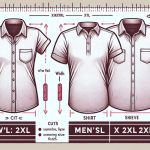Are you tired of buying clothes that don’t fit your body properly? You can learn how to make your own clothes, starting with a raglan sleeve pattern. Raglan sleeves are a popular style in both men’s and women’s clothing, and they provide a comfortable and relaxed fit.
With a little bit of measuring and drafting, you can create a custom-fit pattern that will suit your body perfectly. First, you’ll need to understand what raglan sleeves are and how they differ from other sleeve styles.
Raglan sleeves extend from the neckline to the underarm, creating a diagonal seam that runs from the collarbone to the armpit. This design allows for more movement and flexibility in the arms, making it a popular choice for sports and casual wear.
With this article, you’ll learn how to create your own raglan sleeve pattern and make a garment that will fit your body like a glove. Let’s get started!
Table of Contents
Understanding Raglan Sleeves
Raglan sleeves are a style of sleeve that extend from the collar to the underarm, creating a diagonal seam that runs from the neck to the armpit. They’re named after Lord Raglan, who lost his arm in the Battle of Waterloo and had his tailor create a sleeve that would allow him to move more freely.
Raglan sleeves are known for their distinctive look and fit. They’re often used in sportswear and casual clothing, as they allow for more movement and flexibility than traditional sleeves. They’re also a popular choice for children’s clothing, as they’re easier to dress and undress.
When it comes to making a raglan sleeve pattern, it’s important to understand the basic structure of the sleeve. The diagonal seam should start at the neckline and end at the underarm, with the rest of the sleeve extending down to the wrist. The sleeve should be wider at the top than at the bottom, to accommodate the shape of the shoulder.
With these basic guidelines in mind, you can create a raglan sleeve pattern that will fit your needs perfectly.
Measuring Your Body
To ensure a perfect fit, it’s essential to take accurate measurements of your body before starting any sewing project. Don’t rely on standard sizing charts as they may not reflect your unique body shape.
Once you have your measurements, you may need to make adjustments to the pattern to achieve a custom fit that flatters your figure.
Taking Accurate Measurements
Measuring the circumference of your arm and shoulder is crucial for creating a well-fitting raglan sleeve. To take accurate measurements, start by standing up straight and holding your arms out to the side. Use a tape measure to measure the circumference of your bicep, making sure to keep the tape measure parallel to the ground. Repeat this step for your forearm and wrist, noting down the measurements in a table like the one below.
| Body Part | Measurement Point | Measurement |
|---|---|---|
| Bicep | Widest point | ___ inches |
| Forearm | Widest point | ___ inches |
| Wrist | Widest point | ___ inches |
Next, measure the circumference of your shoulder at its widest point. To do this, place the tape measure at the base of your neck and bring it down to the point where your arm meets your shoulder. Be sure to include the measurement of your back and chest as well. Record this measurement in the table, and double-check that all your measurements are accurate. By following these steps, you’ll be able to create a raglan sleeve that fits you perfectly.
Making Adjustments for a Custom Fit
Once you’ve got your measurements, it’s time to adjust the pattern for a custom fit that’ll make you feel confident and comfortable in your new garment. The first thing you need to do is compare your measurements to the pattern size chart.
If your measurements fall between sizes, you may need to grade between sizes or make adjustments to the pattern to get the perfect fit. To make adjustments, start by making a muslin or mock-up of the pattern. This will allow you to test the fit and make any necessary changes before cutting into your final fabric.
Some common adjustments include adding or subtracting length to the sleeves or body, making the neckline higher or lower, or adjusting the width of the sleeves. With a little patience and some trial and error, you can create a raglan sleeve pattern that fits you perfectly and flatters your body shape.
Drafting the Basic Raglan Sleeve Pattern
Now that we’ve got a clear understanding of the raglan sleeve, let’s delve into the process of drafting the basic pattern.
To start, you’ll need to gather your tools and materials: a ruler, pencil, paper, and a curved ruler or French curve.
Begin by drawing a straight line down the center of your paper. This line represents the center of the sleeve and will be the starting point for your pattern.
Next, draw a horizontal line at the top of the paper. This line represents the neckline and will determine the angle of your raglan sleeve.
From here, you’ll need to draw four diagonal lines that connect the neckline to the center line at a 45-degree angle. These lines represent the raglan seams and will determine the shape of your sleeve.
Once you have these lines in place, use your curved ruler or French curve to connect them smoothly. This will give you the basic shape of your sleeve pattern.
From here, you can make adjustments to suit your individual fit and style preferences.
By following these steps, you’ll be able to create a custom-fit raglan sleeve pattern that’s perfect for you.
Adding Seam Allowances
Now that you’ve drafted your basic raglan sleeve pattern, it’s time to add seam allowances. This is important to ensure that your final garment fits properly and doesn’t unravel at the seams.
To do this, you’ll need to determine the appropriate seam allowance for your fabric and garment style, and then mark it on your pattern using a ruler or tracing wheel. Don’t forget to add seam allowances to all sides of your pattern pieces!
Determining Seam Allowances
To determine the seam allowances for the raglan sleeve pattern, you’ll need to mark the seam lines on the fabric. Start by laying out your fabric on a flat surface and using a straight edge ruler and fabric marker to mark the seam lines, following the pattern instructions.
Take care to ensure that the lines are straight and accurate, as this will affect the fit of the final garment.
Once you’ve marked the seam lines, you can determine the seam allowances. The seam allowance refers to the amount of fabric that is left between the edge of the fabric and the seam line. This allows for the seam to be sewn without the fabric fraying or unraveling.
Typically, a seam allowance of 5/8 inch is used for most sewing projects, but be sure to check the pattern instructions to confirm the correct seam allowance for your project.
With the seam lines marked and seam allowances determined, you’re now ready to cut out your raglan sleeve pattern pieces and start sewing your garment.
Marking the Seam Allowances on the Pattern
Using a ruler and fabric marker, you’ll mark the seam lines on your fabric, ensuring they are straight and accurate for a proper fit. To do this, you’ll need to transfer the seam allowance measurements you determined earlier onto your pattern. Using a ruler, draw a straight line along each seam line on the pattern. Then, using your fabric marker, trace over these lines onto your fabric.
To make it easier to visualize, consider using a table to keep track of your measurements. In the first column, write down the different pattern pieces you’re working with, such as the front, back, and sleeves. In the second column, write down the corresponding seam allowance measurement for each piece. In the third column, write down the total seam line length for each piece. Finally, in the fourth column, write down any notes or special instructions you need to remember for that particular piece. By keeping track of this information, you’ll ensure that your seam allowances and seam lines are accurate and consistent throughout the entire pattern.
Cutting and Sewing the Fabric
First, grab your fabric and lay it flat on a cutting surface with the right side facing up. Make sure your fabric’s free of wrinkles, creases, or any unwanted folds.
Take your raglan sleeve pattern and place it over the fabric. Use weights or pins to hold it in place. Trace the pattern onto the fabric, making sure to transfer all the markings accurately.
Next, cut the fabric along the traced lines. Be careful not to cut through the seam allowances. Remember that you need two pieces of fabric for each sleeve, one for the front and one for the back. Repeat the process for the other sleeve.
Now, it’s time to sew the sleeves to the main body. Take the front and back pieces of the body and lay them right sides together. Pin the sleeves to the armholes, matching the notches.
Sew along the seam allowance, making sure to backstitch at the beginning and the end. Finish the raw edges of the seam allowance by using a serger or a zigzag stitch. Repeat the process for the other sleeve, and you’re done!
You’ve successfully made a raglan sleeve shirt.
Variations on the Basic Pattern
Now that you’ve mastered the basic raglan sleeve shirt, let’s explore some variations to create unique and personalized designs.
One variation is to add a contrast color to the sleeves. You can use a different fabric or even just a different color to create a bold statement. This is a great way to add some personality to a plain shirt or to use up some scrap fabric. Simply cut the sleeve pattern into two pieces at the seam line and sew in the contrast fabric.
Another variation is to adjust the length of the sleeves. You can make them shorter for a more casual look or longer for a dressier option. You can also experiment with the width of the sleeves, making them wider or narrower to suit your preference. This can completely change the look and feel of the shirt.
You can play around with the neckline. You can make it wider or narrower, add a collar or leave it collarless. You can also experiment with different types of necklines, such as a scoop neck or a boat neck. This can give your shirt a completely different vibe and make it stand out from the crowd.
Tips for Perfect Raglan Sleeves
To ensure perfect raglan sleeves, you need to pay attention to a few key points. Firstly, make sure you’re using the right fabric for the job.
Secondly, don’t underestimate the importance of pressing and finishing techniques. And finally, be prepared to troubleshoot any common issues that may arise during the sewing process.
By keeping these tips in mind, you’ll be able to achieve flawless raglan sleeves every time.
Using the Right Fabric
Choose a fabric that drapes well and has a good stretch for a comfortable and flattering fit for your raglan sleeve pattern. Look for fabrics like jersey, knit, or stretchy blends that won’t just provide the necessary stretch for the sleeves but also have a soft and flowing drape.
Avoid stiff or heavy fabrics like denim, canvas, or wool that can make your sleeves feel bulky and restrict your movement. When selecting a fabric for your raglan sleeve pattern, consider the weight and thickness of the fabric.
If the fabric is too thick, it may be difficult to sew and may not drape well. On the other hand, if the fabric is too thin, it may not have enough structure to hold the shape of the sleeves.
Remember that the fabric you choose will affect the final look and feel of your garment, so take your time and choose wisely. With the right fabric, you can create a beautiful and comfortable raglan sleeve pattern that you’ll love to wear.
Pressing and Finishing Techniques
Pressing and finishing the edges of your raglan sleeve garment is essential to create a polished and professional look.
There are different techniques you can use depending on the fabric and the type of finish you want. For example, if you’re working with a knit fabric, you can use a twin needle to hem the edges of your sleeves. This technique creates a clean and stretchy finish that won’t unravel easily.
If you’re using a woven fabric, you can use bias tape to finish the edges of your sleeves. This technique adds a pop of color or texture to your garment and also reinforces the edges, preventing them from fraying.
To apply the bias tape, you can either sew it on the right side of your sleeve and fold it over to the wrong side, or you can sew it on the wrong side and fold it over to the right side. Either way, make sure to press the edges after sewing to ensure a crisp and neat finish.
Remember, pressing and finishing may seem like small details, but they can make a big difference in the overall look of your raglan sleeve garment.
Troubleshooting Common Issues
If you’re experiencing issues with the fit of your garment or the placement of your sleeves, don’t fret – there are simple solutions to common problems.
One common issue is when the sleeve head is too tight or too loose. If it’s too tight, you can try adding a small amount of ease to the sleeve cap by stretching it slightly as you sew it into the armhole. If it’s too loose, you can try easing in the excess fabric by slightly gathering it as you sew it in.
Another issue is when the sleeve twists or puckers at the seam. This can happen if the sleeve is not aligned properly or the seam allowance is too large. To avoid this, make sure the sleeve is properly aligned with the armhole and pin it in place before sewing. Additionally, trim the seam allowance to a reasonable size to reduce bulk.
By taking these simple steps, you can troubleshoot common issues and ensure your raglan sleeve pattern fits perfectly.
- The History and Evolution of Chamois Fabric - June 22, 2025
- Chamois Fabric on Wikipedia: What You Need to Know - June 22, 2025
- How to Pronounce Chamois Fabric Correctly - June 22, 2025





